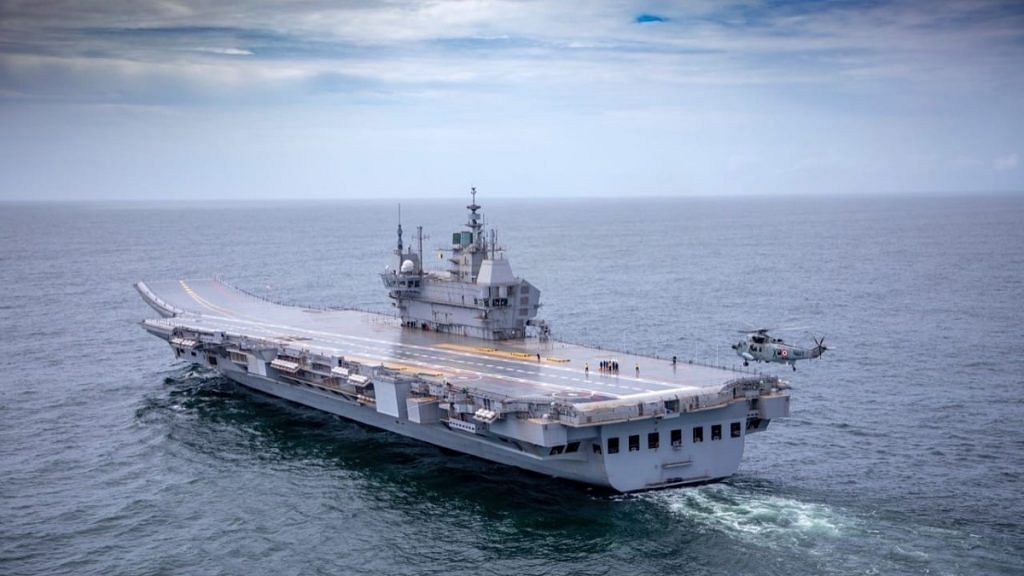Kochi: A floating airfield armed to the teeth with its own battle group, India’s first indigenous aircraft carrier, INS Vikrant, was commissioned into the Indian Navy by Prime Minister Narendra Modi Friday, marking the culmination of a 13-year-long journey.
With a displacement of 42,800 tonnes, Vikrant — which means ‘victorious’ and ‘gallant’ — is the largest ship ever designed and built by India, making it the sixth country to demonstrate the capability to build its own aircraft carrier.
Though design work began in 1999, the keel or backbone of the ship named after India’s erstwhile aircraft carrier INS Vikrant was laid in 2009 and put to water in 2013 with the delivery by Cochin Shipyard Limited to the Indian Navy in 2022.
The erstwhile INS Vikrant, which was commissioned into the Indian Navy in 1961, and saw action in both the 1961 Goa liberation War and the 1971 Bangladesh Liberation War, was decommissioned in 1997.
Powered by four 22 MW Gas Turbine engines, the new INS Vikrant has a range of 7,500 nautical miles (approximately 13,900 km), which translates into a maritime journey from India to Brazil in one go without the need to stop for refuelling.
Capable of carrying a component of 30 aircraft, fighters and helicopters combined, INS Vikrant — which is 262.5 m long and 62.5 m wide — has a top speed of 28 knots (approx. 52 kmph) and a cruise speed of 18 knots (approx. 33 kmph).
Its STOBAR (short take-off and arrested landing) systems will ensure that the Mig-29K aircraft can come to a stop from 250 to 0 kmph on board in less than 90 metres and within two seconds.
In addition to the fighters and helicopters, and its own battle group that sails with it, INS Vikrant is equipped with 32 Medium Range Surface to Air Missile (MRSAM), the AK-630 fully automatic naval rotary cannon close-in weapon system and stabilised remote-controlled guns (SRCG).
The MRSAM, along with the MF-Star radar, would be integrated into INS Vikrant next year by when it will be fully operational.
Vikrant’s eyes and ears comprise RAN-40L 3D air surveillance radar, DRDO-developed Shakti Electronic Warfare suite that will provide an electronic layer of defence against modern radars and anti-ship missiles, and the Rezislor-E Aviation Complex, besides other systems and radars.
For its self-protection, INS Vikrant also has the Kavach Chaff (anti-missile) decoy system, along with Torpedo Decoy System.
Also Read: Indian Navy to get new flag as Modi govt gets rid of colonial St. George’s Cross
Floating city
Giving an insight into the actual size of the aircraft carrier, Navy officials said that the vessel has a height of 61.6 metres (keel to pole mast) — as tall as 14 floors — and the flying deck is about 12,500 sq m — roughly the size of two-and-a-half hockey fields or 10 Olympic-sized swimming pools.
They also explained that the entire cabling used in the ship is 2,600 km long and the power generated by the vessel can actually light up a small town.
INS Vikrant has approximately 2400/2200 spaces and compartments. It is so big that the total stretch of passages and lobbies in the ship comes to about 11 km.
Underneath the flight deck are multiple cabins catered for both men and women, and corridors that go down 10 levels. The vessel can carry a crew of over 1,600 which will include both male and female officers as well as sailors who will be recruited under the Agniveer scheme.
With such a massive crew on board, the ship has its own hospital, fitness centre, kitchen, laundry, and a desalination and RO plant, aside from laundry and living quarters, among other facilities.
The kitchen, Navy officials said, has the capacity to churn out 4,800 meals a day with three automated galleys churning out 16,000 chapatis and 6,000 idlis on average in a single day.
The medical complex, they added, is spread over 45 compartments on three decks and has a 16-bed ward. The medical team comprises five officers and 15 sailors and the setup includes a 64-slice CT scan centre, two operation theatres, a dental centre, X-ray and scanning facility, apart from a full-fledged laboratory, a physiotherapy department, and facilities for blood transfusion.
The ship’s sewage treatment plants are said to be so efficient that Navy officials say the treated water is fit for human consumption. Moreover, its reverse osmosis plants produce over 4 lakh litres every day and its two laundries can cater to over 1,700 individuals every day.
76% indigenous content
INS Vikrant has been built with 76 per cent indigenous content which includes specialised steel, jointly developed by the Steel Authority of India Limited (SAIL) and the Defence Research and Development Organisation (DRDO)
Over 100 MSMEs (Micro, Small and Medium Enterprises) and indigenous original equipment manufacturers (OEMs) were roped in for the construction of this aircraft carrier, apart from over 500 sub-contractors and ancillary industries.
Besides the steel, the carrier’s combat management system, electronic warfare suite, data network, power distribution system, and integrated platform management system were all built indigenously.
The combat management system was built by Tata Advanced Systems, the electronic warfare suite and data network by Bharat Electronics, the power network by L&T, and the integrated platform management system by Bharat Heavy Electricals.
(Edited by Amrtansh Arora)
Also Read: Stung by poor foreign response to submarine project, Modi govt tries to allay industry concerns
